Geography Report: Rainfall Impact on Agricultural Loans in Sri Lanka
VerifiedAdded on 2023/01/18
|13
|3719
|29
Report
AI Summary
This geography report examines the intricate relationship between rainfall patterns, paddy cultivation, and agricultural loans in Sri Lanka. It begins with a glossary of terms, including the IPCC, evapotranspiration, and CROPWAT, before delving into the impact of climate change on Sri Lanka's agro-ecological zones. The report highlights the significance of paddy as a primary crop and the challenges posed by changing rainfall patterns, including the impact on Maha and Yala seasons. It explores the use of tools like the Penman-Monteith formula and CROPWAT for predicting climate change and irrigation needs. Furthermore, the report discusses the impact of water scarcity, the role of agricultural loans, and the potential of ICT in addressing these challenges. It emphasizes the need for resilience analysis and smart investments to ensure the sustainability of agriculture, particularly in the face of climate change and its effects on the socio-economic conditions of farmers. The report concludes by highlighting strategies for improving agricultural practices and increasing farmer income through online services and government schemes.
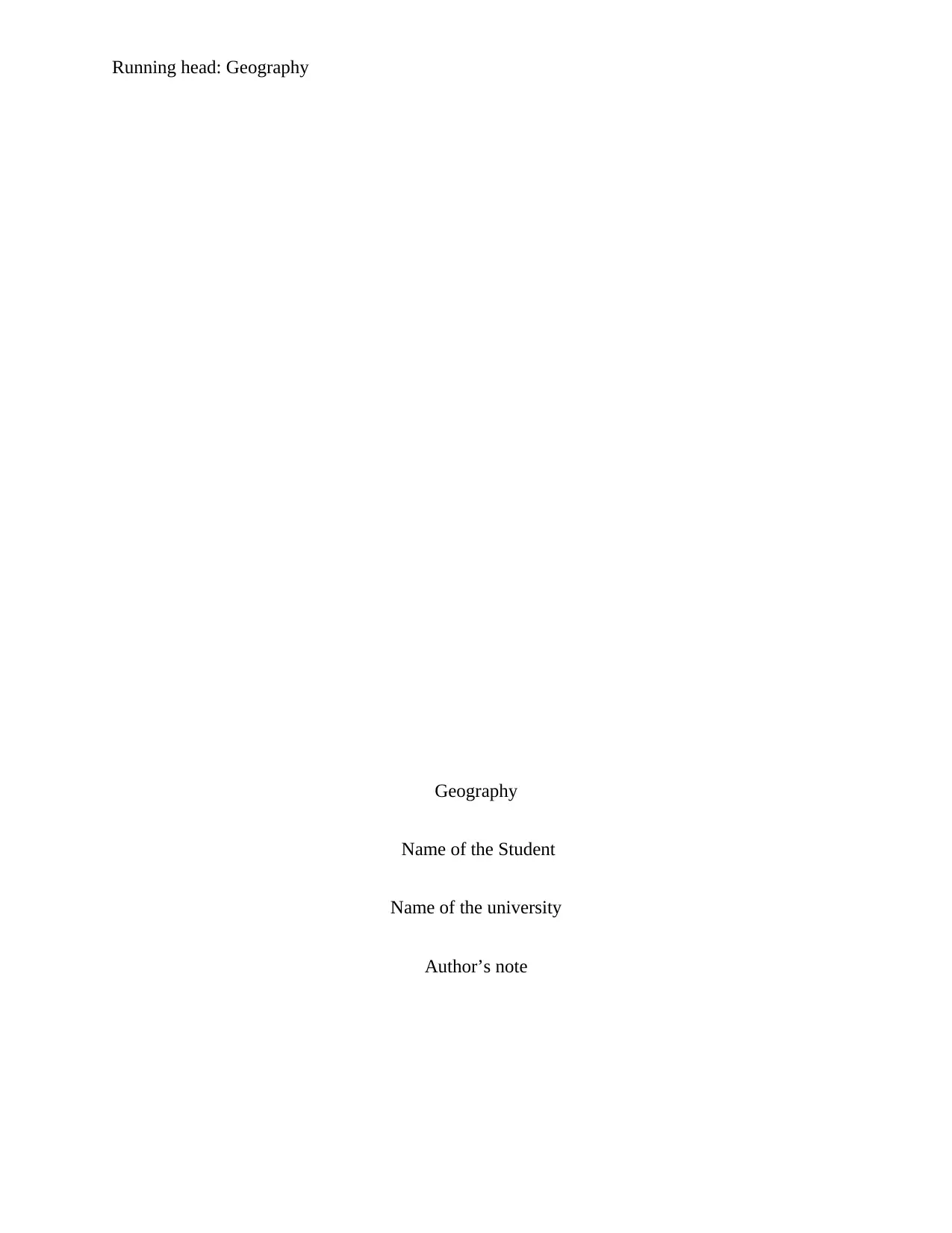
Running head: Geography
Geography
Name of the Student
Name of the university
Author’s note
Geography
Name of the Student
Name of the university
Author’s note
Paraphrase This Document
Need a fresh take? Get an instant paraphrase of this document with our AI Paraphraser
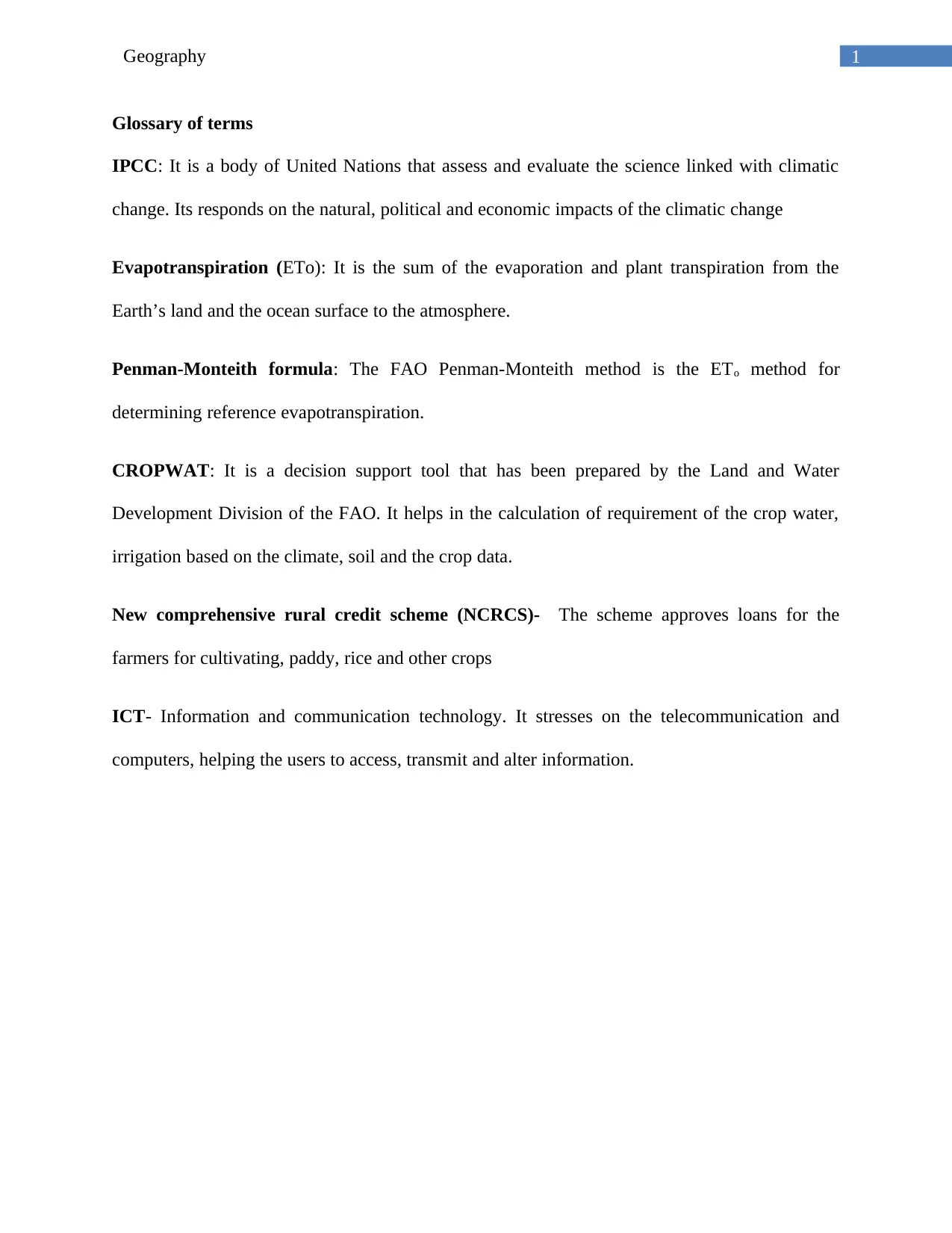
1Geography
Glossary of terms
IPCC: It is a body of United Nations that assess and evaluate the science linked with climatic
change. Its responds on the natural, political and economic impacts of the climatic change
Evapotranspiration (ETo): It is the sum of the evaporation and plant transpiration from the
Earth’s land and the ocean surface to the atmosphere.
Penman-Monteith formula: The FAO Penman-Monteith method is the ETo method for
determining reference evapotranspiration.
CROPWAT: It is a decision support tool that has been prepared by the Land and Water
Development Division of the FAO. It helps in the calculation of requirement of the crop water,
irrigation based on the climate, soil and the crop data.
New comprehensive rural credit scheme (NCRCS)- The scheme approves loans for the
farmers for cultivating, paddy, rice and other crops
ICT- Information and communication technology. It stresses on the telecommunication and
computers, helping the users to access, transmit and alter information.
Glossary of terms
IPCC: It is a body of United Nations that assess and evaluate the science linked with climatic
change. Its responds on the natural, political and economic impacts of the climatic change
Evapotranspiration (ETo): It is the sum of the evaporation and plant transpiration from the
Earth’s land and the ocean surface to the atmosphere.
Penman-Monteith formula: The FAO Penman-Monteith method is the ETo method for
determining reference evapotranspiration.
CROPWAT: It is a decision support tool that has been prepared by the Land and Water
Development Division of the FAO. It helps in the calculation of requirement of the crop water,
irrigation based on the climate, soil and the crop data.
New comprehensive rural credit scheme (NCRCS)- The scheme approves loans for the
farmers for cultivating, paddy, rice and other crops
ICT- Information and communication technology. It stresses on the telecommunication and
computers, helping the users to access, transmit and alter information.
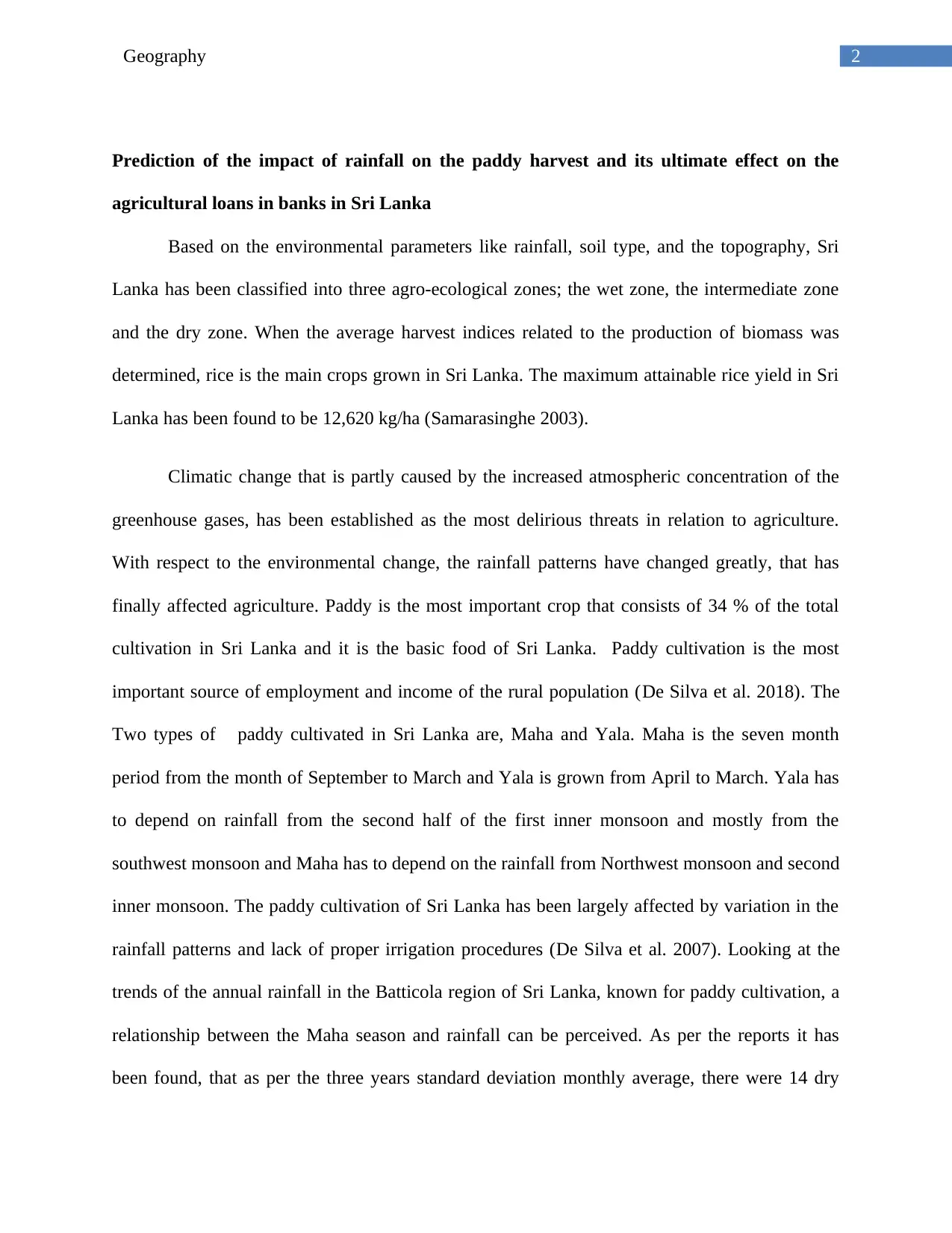
2Geography
Prediction of the impact of rainfall on the paddy harvest and its ultimate effect on the
agricultural loans in banks in Sri Lanka
Based on the environmental parameters like rainfall, soil type, and the topography, Sri
Lanka has been classified into three agro-ecological zones; the wet zone, the intermediate zone
and the dry zone. When the average harvest indices related to the production of biomass was
determined, rice is the main crops grown in Sri Lanka. The maximum attainable rice yield in Sri
Lanka has been found to be 12,620 kg/ha (Samarasinghe 2003).
Climatic change that is partly caused by the increased atmospheric concentration of the
greenhouse gases, has been established as the most delirious threats in relation to agriculture.
With respect to the environmental change, the rainfall patterns have changed greatly, that has
finally affected agriculture. Paddy is the most important crop that consists of 34 % of the total
cultivation in Sri Lanka and it is the basic food of Sri Lanka. Paddy cultivation is the most
important source of employment and income of the rural population (De Silva et al. 2018). The
Two types of paddy cultivated in Sri Lanka are, Maha and Yala. Maha is the seven month
period from the month of September to March and Yala is grown from April to March. Yala has
to depend on rainfall from the second half of the first inner monsoon and mostly from the
southwest monsoon and Maha has to depend on the rainfall from Northwest monsoon and second
inner monsoon. The paddy cultivation of Sri Lanka has been largely affected by variation in the
rainfall patterns and lack of proper irrigation procedures (De Silva et al. 2007). Looking at the
trends of the annual rainfall in the Batticola region of Sri Lanka, known for paddy cultivation, a
relationship between the Maha season and rainfall can be perceived. As per the reports it has
been found, that as per the three years standard deviation monthly average, there were 14 dry
Prediction of the impact of rainfall on the paddy harvest and its ultimate effect on the
agricultural loans in banks in Sri Lanka
Based on the environmental parameters like rainfall, soil type, and the topography, Sri
Lanka has been classified into three agro-ecological zones; the wet zone, the intermediate zone
and the dry zone. When the average harvest indices related to the production of biomass was
determined, rice is the main crops grown in Sri Lanka. The maximum attainable rice yield in Sri
Lanka has been found to be 12,620 kg/ha (Samarasinghe 2003).
Climatic change that is partly caused by the increased atmospheric concentration of the
greenhouse gases, has been established as the most delirious threats in relation to agriculture.
With respect to the environmental change, the rainfall patterns have changed greatly, that has
finally affected agriculture. Paddy is the most important crop that consists of 34 % of the total
cultivation in Sri Lanka and it is the basic food of Sri Lanka. Paddy cultivation is the most
important source of employment and income of the rural population (De Silva et al. 2018). The
Two types of paddy cultivated in Sri Lanka are, Maha and Yala. Maha is the seven month
period from the month of September to March and Yala is grown from April to March. Yala has
to depend on rainfall from the second half of the first inner monsoon and mostly from the
southwest monsoon and Maha has to depend on the rainfall from Northwest monsoon and second
inner monsoon. The paddy cultivation of Sri Lanka has been largely affected by variation in the
rainfall patterns and lack of proper irrigation procedures (De Silva et al. 2007). Looking at the
trends of the annual rainfall in the Batticola region of Sri Lanka, known for paddy cultivation, a
relationship between the Maha season and rainfall can be perceived. As per the reports it has
been found, that as per the three years standard deviation monthly average, there were 14 dry
⊘ This is a preview!⊘
Do you want full access?
Subscribe today to unlock all pages.

Trusted by 1+ million students worldwide
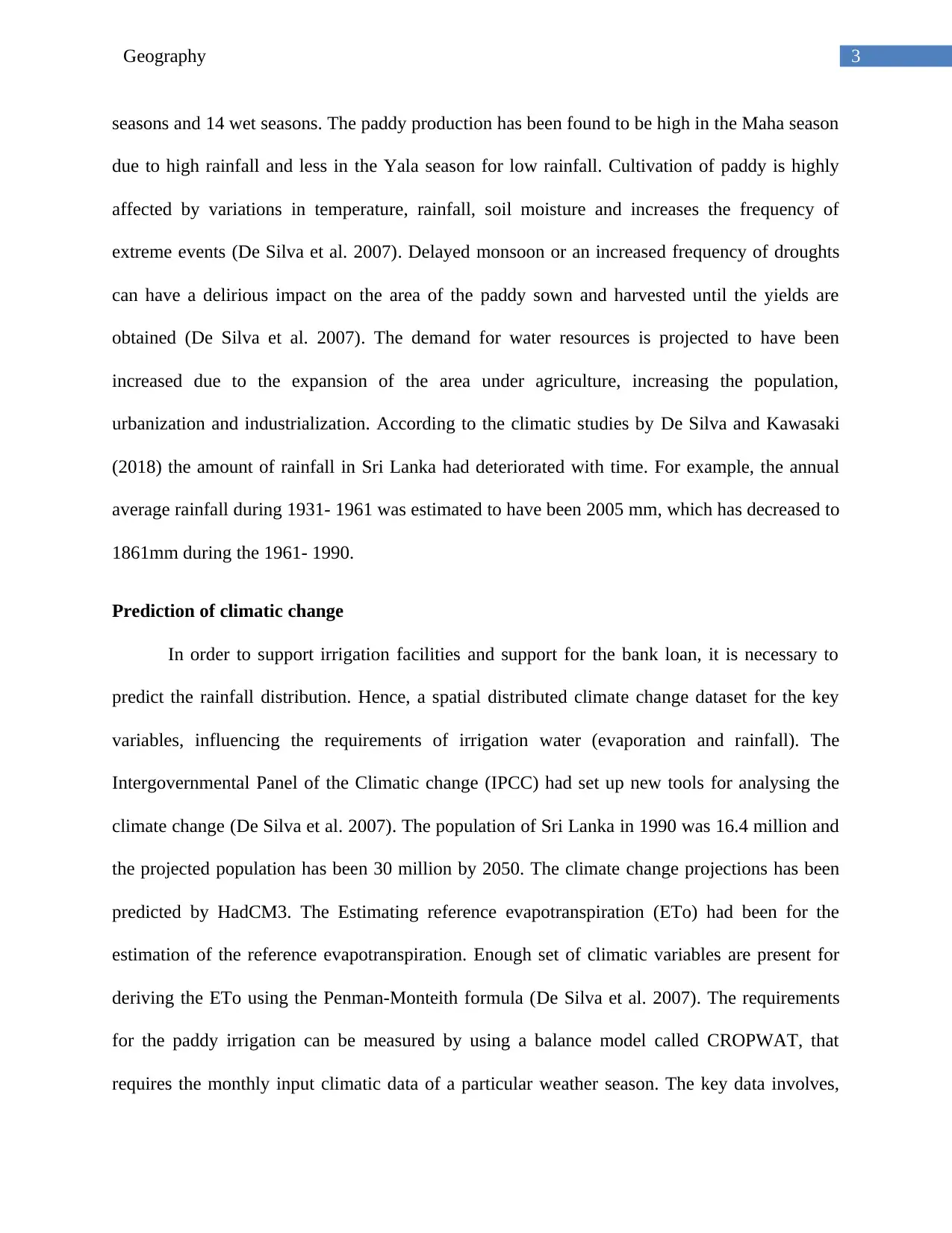
3Geography
seasons and 14 wet seasons. The paddy production has been found to be high in the Maha season
due to high rainfall and less in the Yala season for low rainfall. Cultivation of paddy is highly
affected by variations in temperature, rainfall, soil moisture and increases the frequency of
extreme events (De Silva et al. 2007). Delayed monsoon or an increased frequency of droughts
can have a delirious impact on the area of the paddy sown and harvested until the yields are
obtained (De Silva et al. 2007). The demand for water resources is projected to have been
increased due to the expansion of the area under agriculture, increasing the population,
urbanization and industrialization. According to the climatic studies by De Silva and Kawasaki
(2018) the amount of rainfall in Sri Lanka had deteriorated with time. For example, the annual
average rainfall during 1931- 1961 was estimated to have been 2005 mm, which has decreased to
1861mm during the 1961- 1990.
Prediction of climatic change
In order to support irrigation facilities and support for the bank loan, it is necessary to
predict the rainfall distribution. Hence, a spatial distributed climate change dataset for the key
variables, influencing the requirements of irrigation water (evaporation and rainfall). The
Intergovernmental Panel of the Climatic change (IPCC) had set up new tools for analysing the
climate change (De Silva et al. 2007). The population of Sri Lanka in 1990 was 16.4 million and
the projected population has been 30 million by 2050. The climate change projections has been
predicted by HadCM3. The Estimating reference evapotranspiration (ETo) had been for the
estimation of the reference evapotranspiration. Enough set of climatic variables are present for
deriving the ETo using the Penman-Monteith formula (De Silva et al. 2007). The requirements
for the paddy irrigation can be measured by using a balance model called CROPWAT, that
requires the monthly input climatic data of a particular weather season. The key data involves,
seasons and 14 wet seasons. The paddy production has been found to be high in the Maha season
due to high rainfall and less in the Yala season for low rainfall. Cultivation of paddy is highly
affected by variations in temperature, rainfall, soil moisture and increases the frequency of
extreme events (De Silva et al. 2007). Delayed monsoon or an increased frequency of droughts
can have a delirious impact on the area of the paddy sown and harvested until the yields are
obtained (De Silva et al. 2007). The demand for water resources is projected to have been
increased due to the expansion of the area under agriculture, increasing the population,
urbanization and industrialization. According to the climatic studies by De Silva and Kawasaki
(2018) the amount of rainfall in Sri Lanka had deteriorated with time. For example, the annual
average rainfall during 1931- 1961 was estimated to have been 2005 mm, which has decreased to
1861mm during the 1961- 1990.
Prediction of climatic change
In order to support irrigation facilities and support for the bank loan, it is necessary to
predict the rainfall distribution. Hence, a spatial distributed climate change dataset for the key
variables, influencing the requirements of irrigation water (evaporation and rainfall). The
Intergovernmental Panel of the Climatic change (IPCC) had set up new tools for analysing the
climate change (De Silva et al. 2007). The population of Sri Lanka in 1990 was 16.4 million and
the projected population has been 30 million by 2050. The climate change projections has been
predicted by HadCM3. The Estimating reference evapotranspiration (ETo) had been for the
estimation of the reference evapotranspiration. Enough set of climatic variables are present for
deriving the ETo using the Penman-Monteith formula (De Silva et al. 2007). The requirements
for the paddy irrigation can be measured by using a balance model called CROPWAT, that
requires the monthly input climatic data of a particular weather season. The key data involves,
Paraphrase This Document
Need a fresh take? Get an instant paraphrase of this document with our AI Paraphraser
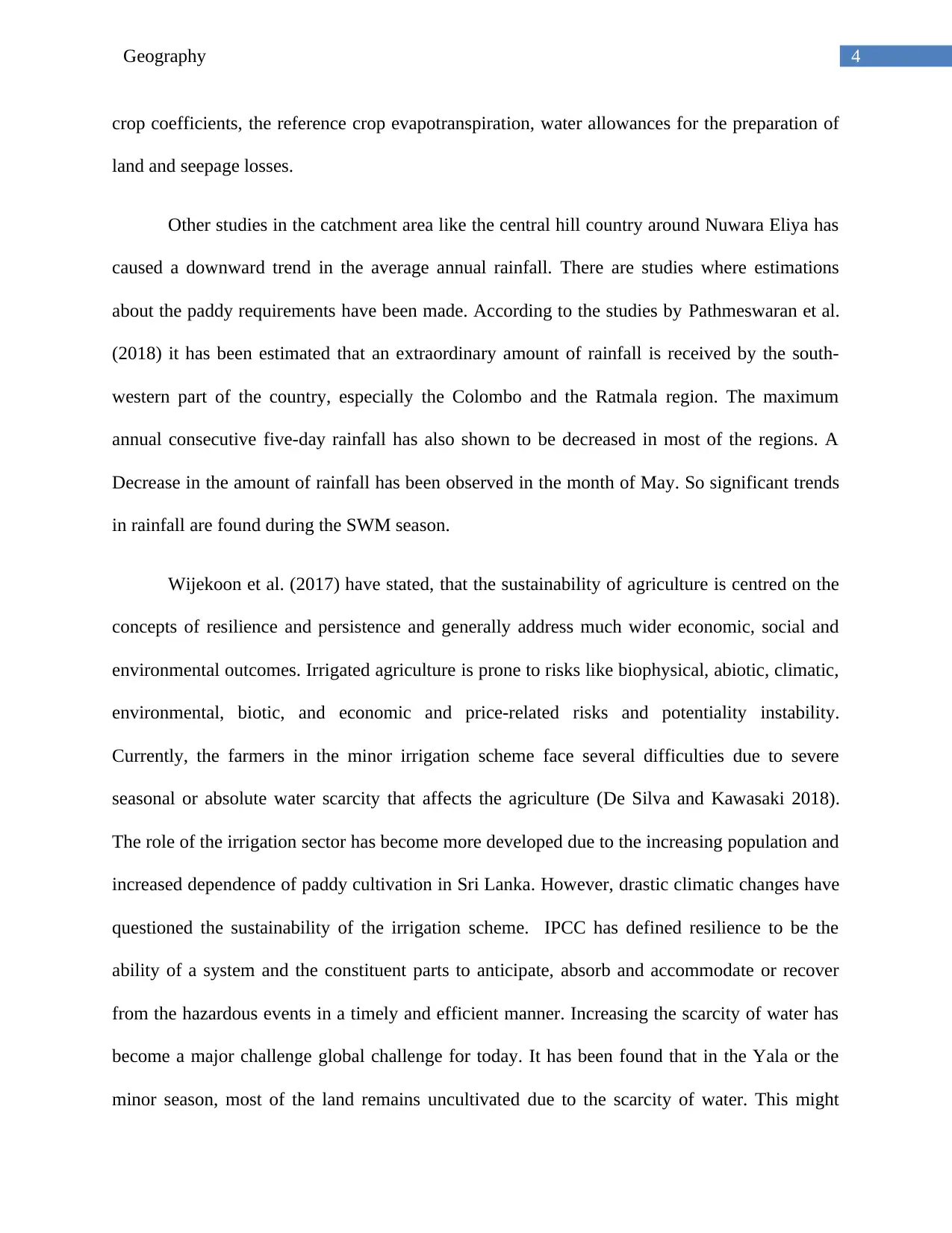
4Geography
crop coefficients, the reference crop evapotranspiration, water allowances for the preparation of
land and seepage losses.
Other studies in the catchment area like the central hill country around Nuwara Eliya has
caused a downward trend in the average annual rainfall. There are studies where estimations
about the paddy requirements have been made. According to the studies by Pathmeswaran et al.
(2018) it has been estimated that an extraordinary amount of rainfall is received by the south-
western part of the country, especially the Colombo and the Ratmala region. The maximum
annual consecutive five-day rainfall has also shown to be decreased in most of the regions. A
Decrease in the amount of rainfall has been observed in the month of May. So significant trends
in rainfall are found during the SWM season.
Wijekoon et al. (2017) have stated, that the sustainability of agriculture is centred on the
concepts of resilience and persistence and generally address much wider economic, social and
environmental outcomes. Irrigated agriculture is prone to risks like biophysical, abiotic, climatic,
environmental, biotic, and economic and price-related risks and potentiality instability.
Currently, the farmers in the minor irrigation scheme face several difficulties due to severe
seasonal or absolute water scarcity that affects the agriculture (De Silva and Kawasaki 2018).
The role of the irrigation sector has become more developed due to the increasing population and
increased dependence of paddy cultivation in Sri Lanka. However, drastic climatic changes have
questioned the sustainability of the irrigation scheme. IPCC has defined resilience to be the
ability of a system and the constituent parts to anticipate, absorb and accommodate or recover
from the hazardous events in a timely and efficient manner. Increasing the scarcity of water has
become a major challenge global challenge for today. It has been found that in the Yala or the
minor season, most of the land remains uncultivated due to the scarcity of water. This might
crop coefficients, the reference crop evapotranspiration, water allowances for the preparation of
land and seepage losses.
Other studies in the catchment area like the central hill country around Nuwara Eliya has
caused a downward trend in the average annual rainfall. There are studies where estimations
about the paddy requirements have been made. According to the studies by Pathmeswaran et al.
(2018) it has been estimated that an extraordinary amount of rainfall is received by the south-
western part of the country, especially the Colombo and the Ratmala region. The maximum
annual consecutive five-day rainfall has also shown to be decreased in most of the regions. A
Decrease in the amount of rainfall has been observed in the month of May. So significant trends
in rainfall are found during the SWM season.
Wijekoon et al. (2017) have stated, that the sustainability of agriculture is centred on the
concepts of resilience and persistence and generally address much wider economic, social and
environmental outcomes. Irrigated agriculture is prone to risks like biophysical, abiotic, climatic,
environmental, biotic, and economic and price-related risks and potentiality instability.
Currently, the farmers in the minor irrigation scheme face several difficulties due to severe
seasonal or absolute water scarcity that affects the agriculture (De Silva and Kawasaki 2018).
The role of the irrigation sector has become more developed due to the increasing population and
increased dependence of paddy cultivation in Sri Lanka. However, drastic climatic changes have
questioned the sustainability of the irrigation scheme. IPCC has defined resilience to be the
ability of a system and the constituent parts to anticipate, absorb and accommodate or recover
from the hazardous events in a timely and efficient manner. Increasing the scarcity of water has
become a major challenge global challenge for today. It has been found that in the Yala or the
minor season, most of the land remains uncultivated due to the scarcity of water. This might
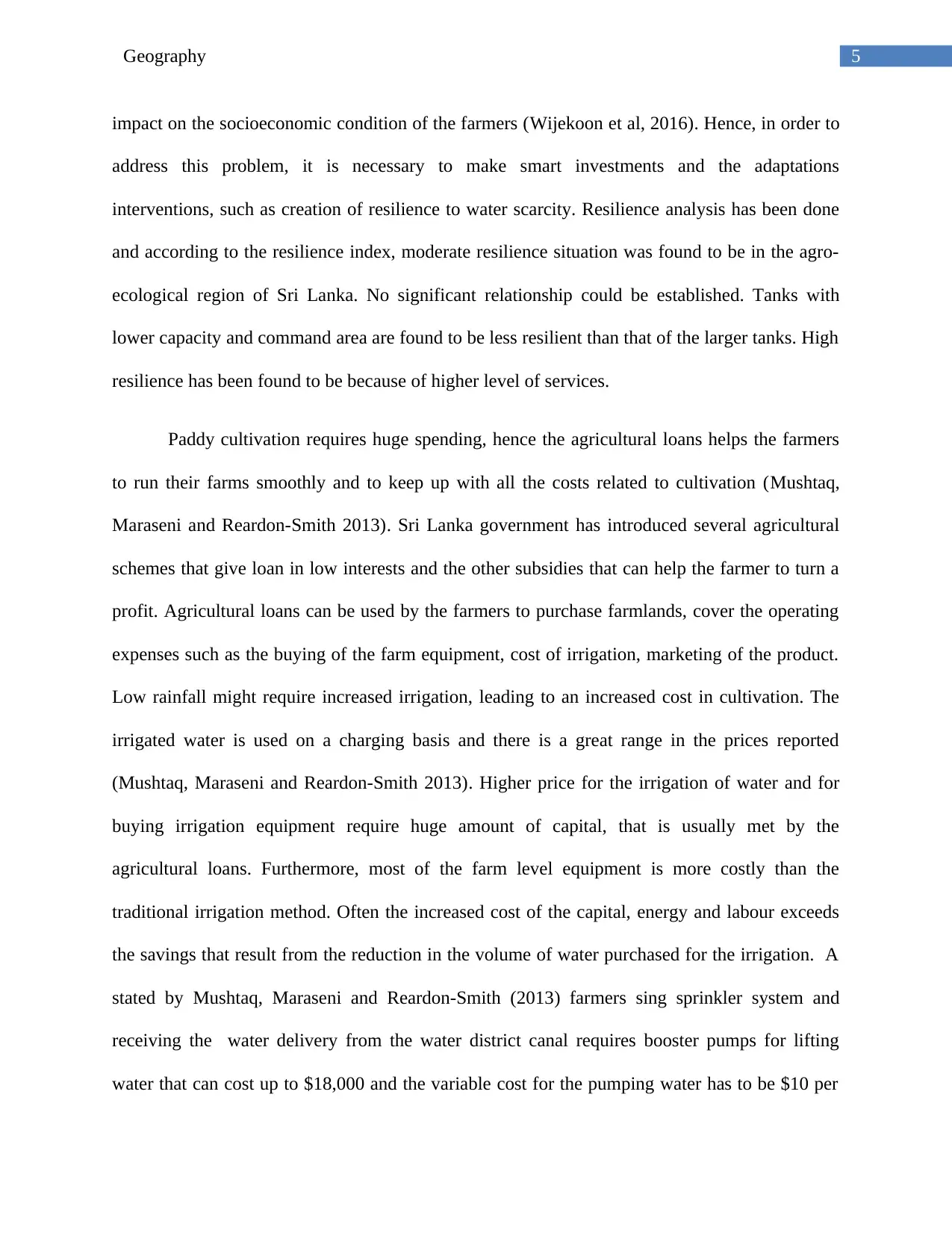
5Geography
impact on the socioeconomic condition of the farmers (Wijekoon et al, 2016). Hence, in order to
address this problem, it is necessary to make smart investments and the adaptations
interventions, such as creation of resilience to water scarcity. Resilience analysis has been done
and according to the resilience index, moderate resilience situation was found to be in the agro-
ecological region of Sri Lanka. No significant relationship could be established. Tanks with
lower capacity and command area are found to be less resilient than that of the larger tanks. High
resilience has been found to be because of higher level of services.
Paddy cultivation requires huge spending, hence the agricultural loans helps the farmers
to run their farms smoothly and to keep up with all the costs related to cultivation (Mushtaq,
Maraseni and Reardon-Smith 2013). Sri Lanka government has introduced several agricultural
schemes that give loan in low interests and the other subsidies that can help the farmer to turn a
profit. Agricultural loans can be used by the farmers to purchase farmlands, cover the operating
expenses such as the buying of the farm equipment, cost of irrigation, marketing of the product.
Low rainfall might require increased irrigation, leading to an increased cost in cultivation. The
irrigated water is used on a charging basis and there is a great range in the prices reported
(Mushtaq, Maraseni and Reardon-Smith 2013). Higher price for the irrigation of water and for
buying irrigation equipment require huge amount of capital, that is usually met by the
agricultural loans. Furthermore, most of the farm level equipment is more costly than the
traditional irrigation method. Often the increased cost of the capital, energy and labour exceeds
the savings that result from the reduction in the volume of water purchased for the irrigation. A
stated by Mushtaq, Maraseni and Reardon-Smith (2013) farmers sing sprinkler system and
receiving the water delivery from the water district canal requires booster pumps for lifting
water that can cost up to $18,000 and the variable cost for the pumping water has to be $10 per
impact on the socioeconomic condition of the farmers (Wijekoon et al, 2016). Hence, in order to
address this problem, it is necessary to make smart investments and the adaptations
interventions, such as creation of resilience to water scarcity. Resilience analysis has been done
and according to the resilience index, moderate resilience situation was found to be in the agro-
ecological region of Sri Lanka. No significant relationship could be established. Tanks with
lower capacity and command area are found to be less resilient than that of the larger tanks. High
resilience has been found to be because of higher level of services.
Paddy cultivation requires huge spending, hence the agricultural loans helps the farmers
to run their farms smoothly and to keep up with all the costs related to cultivation (Mushtaq,
Maraseni and Reardon-Smith 2013). Sri Lanka government has introduced several agricultural
schemes that give loan in low interests and the other subsidies that can help the farmer to turn a
profit. Agricultural loans can be used by the farmers to purchase farmlands, cover the operating
expenses such as the buying of the farm equipment, cost of irrigation, marketing of the product.
Low rainfall might require increased irrigation, leading to an increased cost in cultivation. The
irrigated water is used on a charging basis and there is a great range in the prices reported
(Mushtaq, Maraseni and Reardon-Smith 2013). Higher price for the irrigation of water and for
buying irrigation equipment require huge amount of capital, that is usually met by the
agricultural loans. Furthermore, most of the farm level equipment is more costly than the
traditional irrigation method. Often the increased cost of the capital, energy and labour exceeds
the savings that result from the reduction in the volume of water purchased for the irrigation. A
stated by Mushtaq, Maraseni and Reardon-Smith (2013) farmers sing sprinkler system and
receiving the water delivery from the water district canal requires booster pumps for lifting
water that can cost up to $18,000 and the variable cost for the pumping water has to be $10 per
⊘ This is a preview!⊘
Do you want full access?
Subscribe today to unlock all pages.

Trusted by 1+ million students worldwide
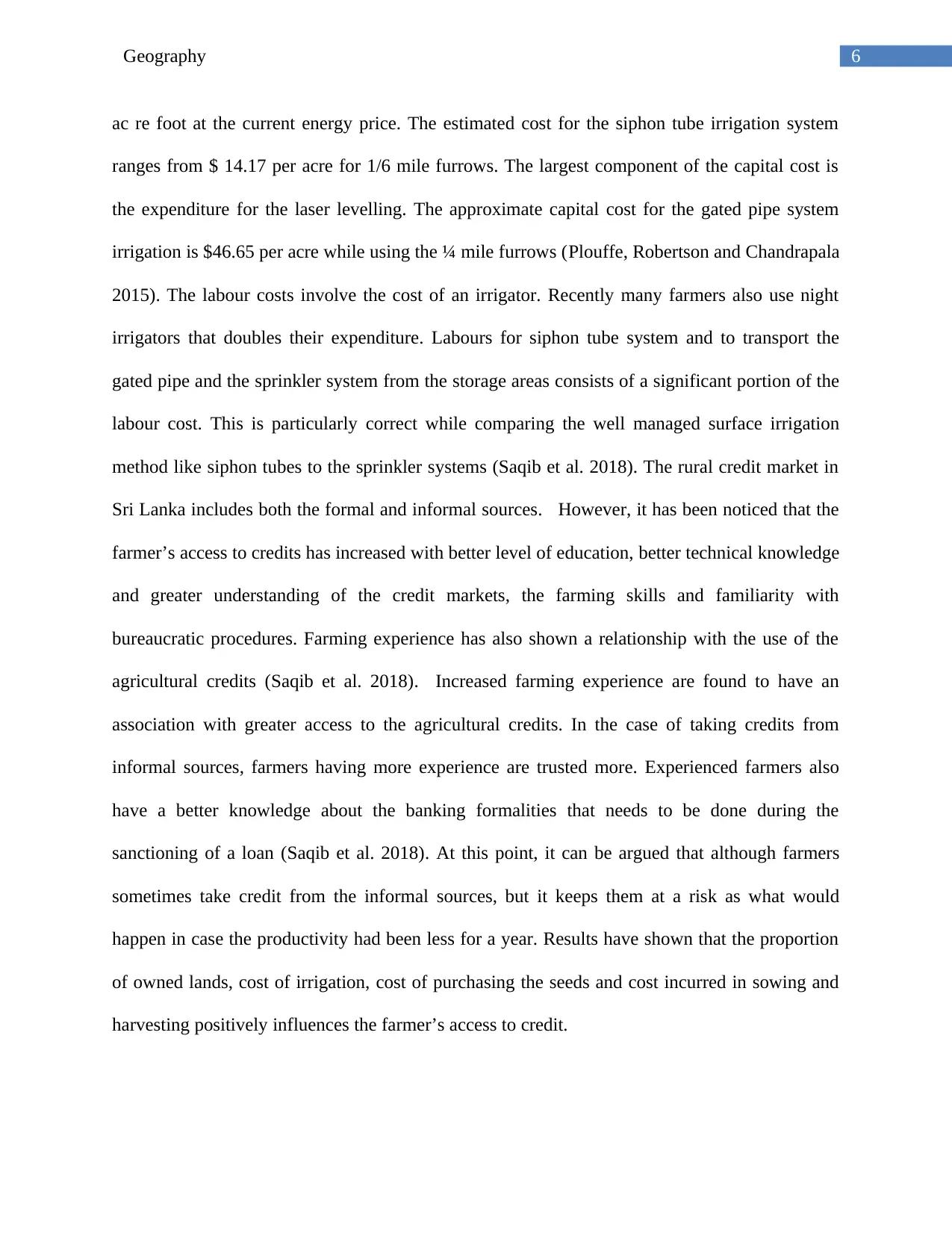
6Geography
ac re foot at the current energy price. The estimated cost for the siphon tube irrigation system
ranges from $ 14.17 per acre for 1/6 mile furrows. The largest component of the capital cost is
the expenditure for the laser levelling. The approximate capital cost for the gated pipe system
irrigation is $46.65 per acre while using the ¼ mile furrows (Plouffe, Robertson and Chandrapala
2015). The labour costs involve the cost of an irrigator. Recently many farmers also use night
irrigators that doubles their expenditure. Labours for siphon tube system and to transport the
gated pipe and the sprinkler system from the storage areas consists of a significant portion of the
labour cost. This is particularly correct while comparing the well managed surface irrigation
method like siphon tubes to the sprinkler systems (Saqib et al. 2018). The rural credit market in
Sri Lanka includes both the formal and informal sources. However, it has been noticed that the
farmer’s access to credits has increased with better level of education, better technical knowledge
and greater understanding of the credit markets, the farming skills and familiarity with
bureaucratic procedures. Farming experience has also shown a relationship with the use of the
agricultural credits (Saqib et al. 2018). Increased farming experience are found to have an
association with greater access to the agricultural credits. In the case of taking credits from
informal sources, farmers having more experience are trusted more. Experienced farmers also
have a better knowledge about the banking formalities that needs to be done during the
sanctioning of a loan (Saqib et al. 2018). At this point, it can be argued that although farmers
sometimes take credit from the informal sources, but it keeps them at a risk as what would
happen in case the productivity had been less for a year. Results have shown that the proportion
of owned lands, cost of irrigation, cost of purchasing the seeds and cost incurred in sowing and
harvesting positively influences the farmer’s access to credit.
ac re foot at the current energy price. The estimated cost for the siphon tube irrigation system
ranges from $ 14.17 per acre for 1/6 mile furrows. The largest component of the capital cost is
the expenditure for the laser levelling. The approximate capital cost for the gated pipe system
irrigation is $46.65 per acre while using the ¼ mile furrows (Plouffe, Robertson and Chandrapala
2015). The labour costs involve the cost of an irrigator. Recently many farmers also use night
irrigators that doubles their expenditure. Labours for siphon tube system and to transport the
gated pipe and the sprinkler system from the storage areas consists of a significant portion of the
labour cost. This is particularly correct while comparing the well managed surface irrigation
method like siphon tubes to the sprinkler systems (Saqib et al. 2018). The rural credit market in
Sri Lanka includes both the formal and informal sources. However, it has been noticed that the
farmer’s access to credits has increased with better level of education, better technical knowledge
and greater understanding of the credit markets, the farming skills and familiarity with
bureaucratic procedures. Farming experience has also shown a relationship with the use of the
agricultural credits (Saqib et al. 2018). Increased farming experience are found to have an
association with greater access to the agricultural credits. In the case of taking credits from
informal sources, farmers having more experience are trusted more. Experienced farmers also
have a better knowledge about the banking formalities that needs to be done during the
sanctioning of a loan (Saqib et al. 2018). At this point, it can be argued that although farmers
sometimes take credit from the informal sources, but it keeps them at a risk as what would
happen in case the productivity had been less for a year. Results have shown that the proportion
of owned lands, cost of irrigation, cost of purchasing the seeds and cost incurred in sowing and
harvesting positively influences the farmer’s access to credit.
Paraphrase This Document
Need a fresh take? Get an instant paraphrase of this document with our AI Paraphraser
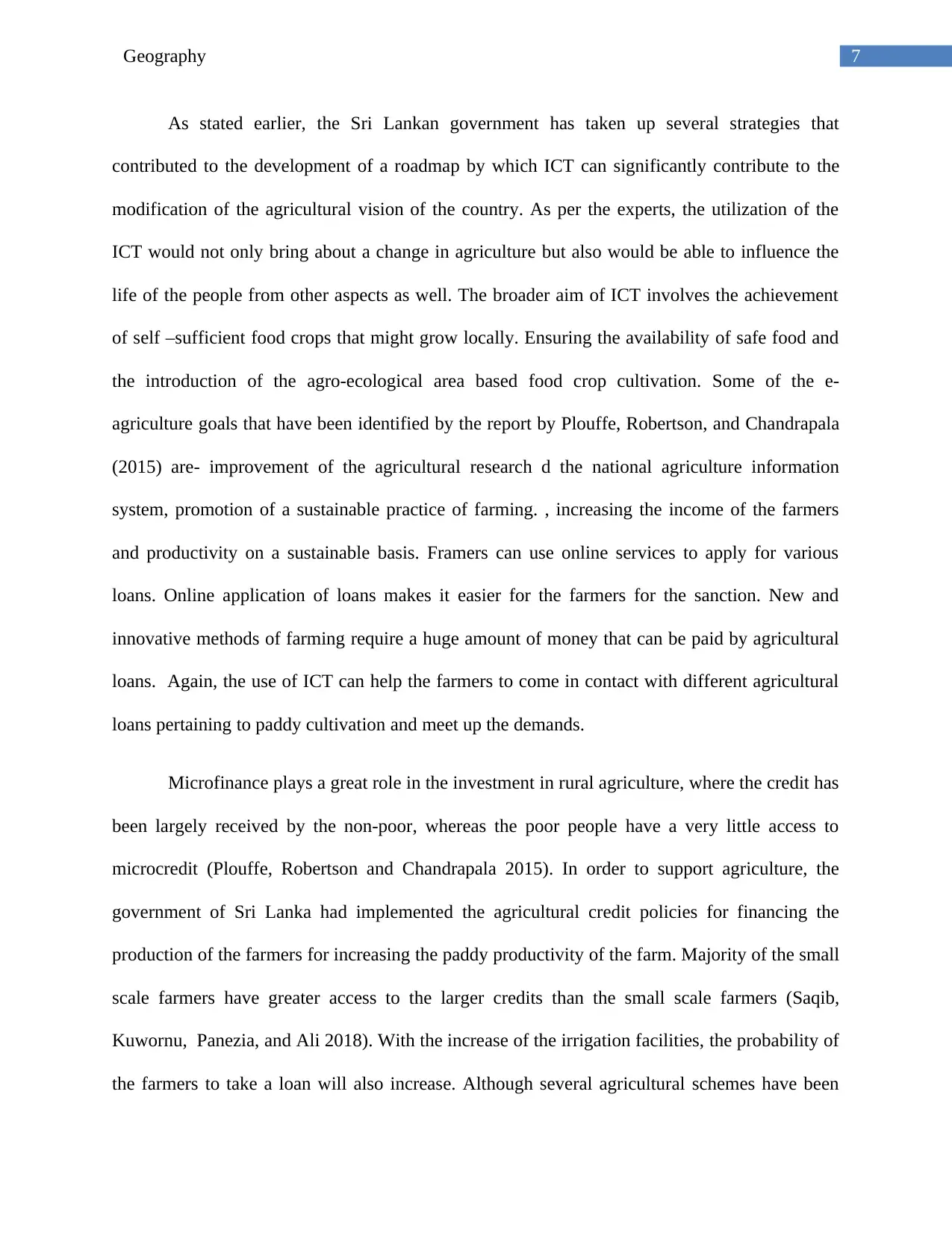
7Geography
As stated earlier, the Sri Lankan government has taken up several strategies that
contributed to the development of a roadmap by which ICT can significantly contribute to the
modification of the agricultural vision of the country. As per the experts, the utilization of the
ICT would not only bring about a change in agriculture but also would be able to influence the
life of the people from other aspects as well. The broader aim of ICT involves the achievement
of self –sufficient food crops that might grow locally. Ensuring the availability of safe food and
the introduction of the agro-ecological area based food crop cultivation. Some of the e-
agriculture goals that have been identified by the report by Plouffe, Robertson, and Chandrapala
(2015) are- improvement of the agricultural research d the national agriculture information
system, promotion of a sustainable practice of farming. , increasing the income of the farmers
and productivity on a sustainable basis. Framers can use online services to apply for various
loans. Online application of loans makes it easier for the farmers for the sanction. New and
innovative methods of farming require a huge amount of money that can be paid by agricultural
loans. Again, the use of ICT can help the farmers to come in contact with different agricultural
loans pertaining to paddy cultivation and meet up the demands.
Microfinance plays a great role in the investment in rural agriculture, where the credit has
been largely received by the non-poor, whereas the poor people have a very little access to
microcredit (Plouffe, Robertson and Chandrapala 2015). In order to support agriculture, the
government of Sri Lanka had implemented the agricultural credit policies for financing the
production of the farmers for increasing the paddy productivity of the farm. Majority of the small
scale farmers have greater access to the larger credits than the small scale farmers (Saqib,
Kuwornu, Panezia, and Ali 2018). With the increase of the irrigation facilities, the probability of
the farmers to take a loan will also increase. Although several agricultural schemes have been
As stated earlier, the Sri Lankan government has taken up several strategies that
contributed to the development of a roadmap by which ICT can significantly contribute to the
modification of the agricultural vision of the country. As per the experts, the utilization of the
ICT would not only bring about a change in agriculture but also would be able to influence the
life of the people from other aspects as well. The broader aim of ICT involves the achievement
of self –sufficient food crops that might grow locally. Ensuring the availability of safe food and
the introduction of the agro-ecological area based food crop cultivation. Some of the e-
agriculture goals that have been identified by the report by Plouffe, Robertson, and Chandrapala
(2015) are- improvement of the agricultural research d the national agriculture information
system, promotion of a sustainable practice of farming. , increasing the income of the farmers
and productivity on a sustainable basis. Framers can use online services to apply for various
loans. Online application of loans makes it easier for the farmers for the sanction. New and
innovative methods of farming require a huge amount of money that can be paid by agricultural
loans. Again, the use of ICT can help the farmers to come in contact with different agricultural
loans pertaining to paddy cultivation and meet up the demands.
Microfinance plays a great role in the investment in rural agriculture, where the credit has
been largely received by the non-poor, whereas the poor people have a very little access to
microcredit (Plouffe, Robertson and Chandrapala 2015). In order to support agriculture, the
government of Sri Lanka had implemented the agricultural credit policies for financing the
production of the farmers for increasing the paddy productivity of the farm. Majority of the small
scale farmers have greater access to the larger credits than the small scale farmers (Saqib,
Kuwornu, Panezia, and Ali 2018). With the increase of the irrigation facilities, the probability of
the farmers to take a loan will also increase. Although several agricultural schemes have been
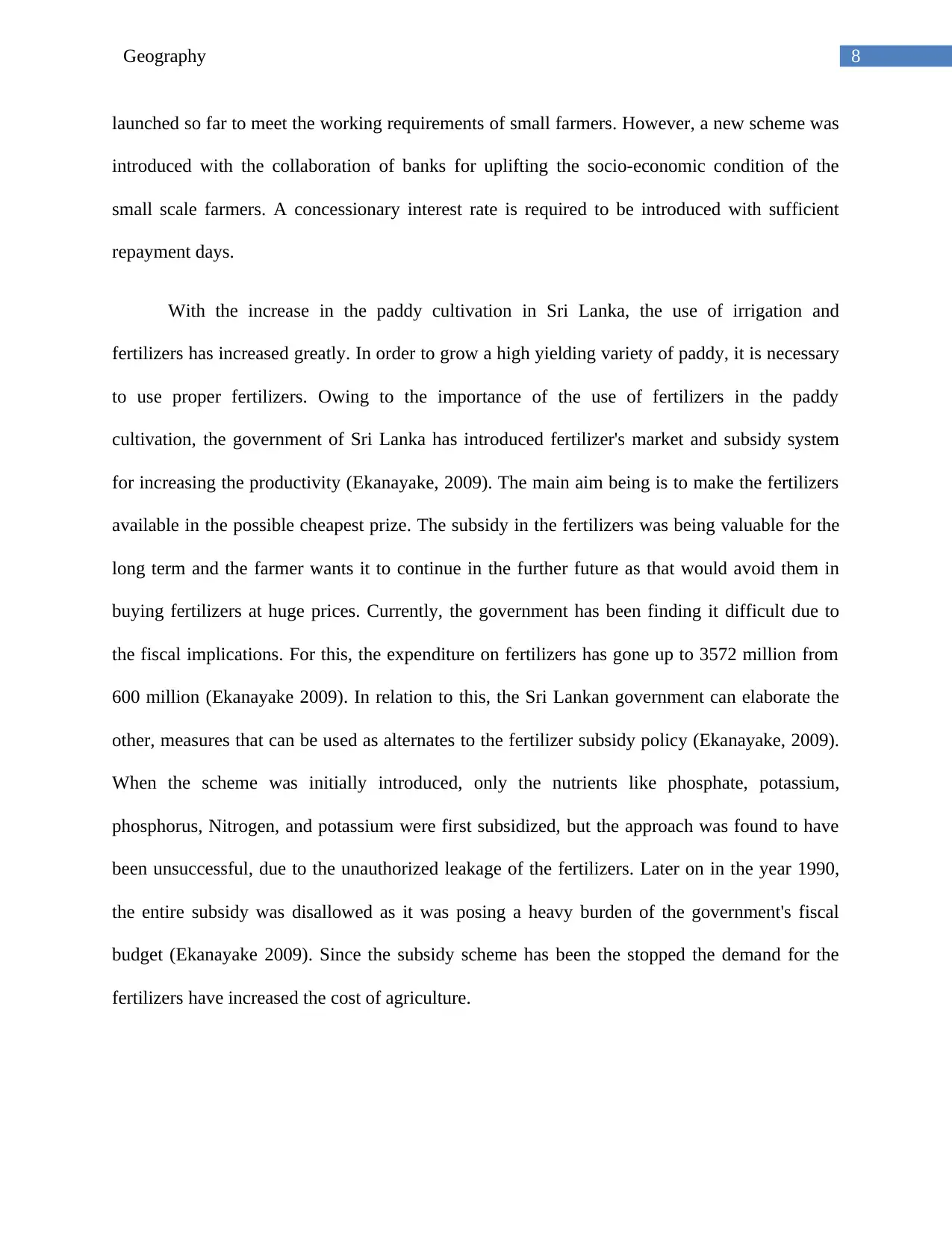
8Geography
launched so far to meet the working requirements of small farmers. However, a new scheme was
introduced with the collaboration of banks for uplifting the socio-economic condition of the
small scale farmers. A concessionary interest rate is required to be introduced with sufficient
repayment days.
With the increase in the paddy cultivation in Sri Lanka, the use of irrigation and
fertilizers has increased greatly. In order to grow a high yielding variety of paddy, it is necessary
to use proper fertilizers. Owing to the importance of the use of fertilizers in the paddy
cultivation, the government of Sri Lanka has introduced fertilizer's market and subsidy system
for increasing the productivity (Ekanayake, 2009). The main aim being is to make the fertilizers
available in the possible cheapest prize. The subsidy in the fertilizers was being valuable for the
long term and the farmer wants it to continue in the further future as that would avoid them in
buying fertilizers at huge prices. Currently, the government has been finding it difficult due to
the fiscal implications. For this, the expenditure on fertilizers has gone up to 3572 million from
600 million (Ekanayake 2009). In relation to this, the Sri Lankan government can elaborate the
other, measures that can be used as alternates to the fertilizer subsidy policy (Ekanayake, 2009).
When the scheme was initially introduced, only the nutrients like phosphate, potassium,
phosphorus, Nitrogen, and potassium were first subsidized, but the approach was found to have
been unsuccessful, due to the unauthorized leakage of the fertilizers. Later on in the year 1990,
the entire subsidy was disallowed as it was posing a heavy burden of the government's fiscal
budget (Ekanayake 2009). Since the subsidy scheme has been the stopped the demand for the
fertilizers have increased the cost of agriculture.
launched so far to meet the working requirements of small farmers. However, a new scheme was
introduced with the collaboration of banks for uplifting the socio-economic condition of the
small scale farmers. A concessionary interest rate is required to be introduced with sufficient
repayment days.
With the increase in the paddy cultivation in Sri Lanka, the use of irrigation and
fertilizers has increased greatly. In order to grow a high yielding variety of paddy, it is necessary
to use proper fertilizers. Owing to the importance of the use of fertilizers in the paddy
cultivation, the government of Sri Lanka has introduced fertilizer's market and subsidy system
for increasing the productivity (Ekanayake, 2009). The main aim being is to make the fertilizers
available in the possible cheapest prize. The subsidy in the fertilizers was being valuable for the
long term and the farmer wants it to continue in the further future as that would avoid them in
buying fertilizers at huge prices. Currently, the government has been finding it difficult due to
the fiscal implications. For this, the expenditure on fertilizers has gone up to 3572 million from
600 million (Ekanayake 2009). In relation to this, the Sri Lankan government can elaborate the
other, measures that can be used as alternates to the fertilizer subsidy policy (Ekanayake, 2009).
When the scheme was initially introduced, only the nutrients like phosphate, potassium,
phosphorus, Nitrogen, and potassium were first subsidized, but the approach was found to have
been unsuccessful, due to the unauthorized leakage of the fertilizers. Later on in the year 1990,
the entire subsidy was disallowed as it was posing a heavy burden of the government's fiscal
budget (Ekanayake 2009). Since the subsidy scheme has been the stopped the demand for the
fertilizers have increased the cost of agriculture.
⊘ This is a preview!⊘
Do you want full access?
Subscribe today to unlock all pages.

Trusted by 1+ million students worldwide
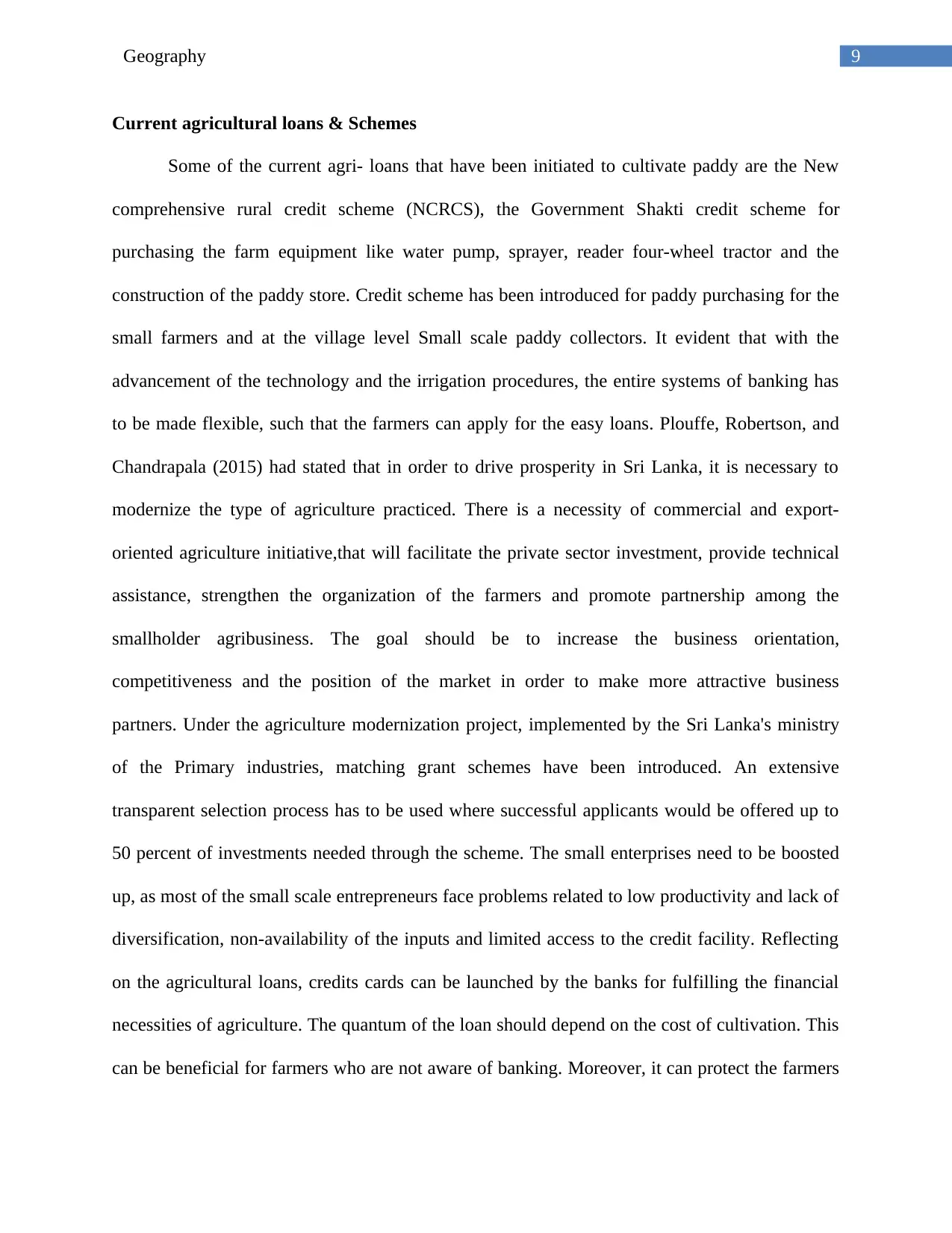
9Geography
Current agricultural loans & Schemes
Some of the current agri- loans that have been initiated to cultivate paddy are the New
comprehensive rural credit scheme (NCRCS), the Government Shakti credit scheme for
purchasing the farm equipment like water pump, sprayer, reader four-wheel tractor and the
construction of the paddy store. Credit scheme has been introduced for paddy purchasing for the
small farmers and at the village level Small scale paddy collectors. It evident that with the
advancement of the technology and the irrigation procedures, the entire systems of banking has
to be made flexible, such that the farmers can apply for the easy loans. Plouffe, Robertson, and
Chandrapala (2015) had stated that in order to drive prosperity in Sri Lanka, it is necessary to
modernize the type of agriculture practiced. There is a necessity of commercial and export-
oriented agriculture initiative,that will facilitate the private sector investment, provide technical
assistance, strengthen the organization of the farmers and promote partnership among the
smallholder agribusiness. The goal should be to increase the business orientation,
competitiveness and the position of the market in order to make more attractive business
partners. Under the agriculture modernization project, implemented by the Sri Lanka's ministry
of the Primary industries, matching grant schemes have been introduced. An extensive
transparent selection process has to be used where successful applicants would be offered up to
50 percent of investments needed through the scheme. The small enterprises need to be boosted
up, as most of the small scale entrepreneurs face problems related to low productivity and lack of
diversification, non-availability of the inputs and limited access to the credit facility. Reflecting
on the agricultural loans, credits cards can be launched by the banks for fulfilling the financial
necessities of agriculture. The quantum of the loan should depend on the cost of cultivation. This
can be beneficial for farmers who are not aware of banking. Moreover, it can protect the farmers
Current agricultural loans & Schemes
Some of the current agri- loans that have been initiated to cultivate paddy are the New
comprehensive rural credit scheme (NCRCS), the Government Shakti credit scheme for
purchasing the farm equipment like water pump, sprayer, reader four-wheel tractor and the
construction of the paddy store. Credit scheme has been introduced for paddy purchasing for the
small farmers and at the village level Small scale paddy collectors. It evident that with the
advancement of the technology and the irrigation procedures, the entire systems of banking has
to be made flexible, such that the farmers can apply for the easy loans. Plouffe, Robertson, and
Chandrapala (2015) had stated that in order to drive prosperity in Sri Lanka, it is necessary to
modernize the type of agriculture practiced. There is a necessity of commercial and export-
oriented agriculture initiative,that will facilitate the private sector investment, provide technical
assistance, strengthen the organization of the farmers and promote partnership among the
smallholder agribusiness. The goal should be to increase the business orientation,
competitiveness and the position of the market in order to make more attractive business
partners. Under the agriculture modernization project, implemented by the Sri Lanka's ministry
of the Primary industries, matching grant schemes have been introduced. An extensive
transparent selection process has to be used where successful applicants would be offered up to
50 percent of investments needed through the scheme. The small enterprises need to be boosted
up, as most of the small scale entrepreneurs face problems related to low productivity and lack of
diversification, non-availability of the inputs and limited access to the credit facility. Reflecting
on the agricultural loans, credits cards can be launched by the banks for fulfilling the financial
necessities of agriculture. The quantum of the loan should depend on the cost of cultivation. This
can be beneficial for farmers who are not aware of banking. Moreover, it can protect the farmers
Paraphrase This Document
Need a fresh take? Get an instant paraphrase of this document with our AI Paraphraser
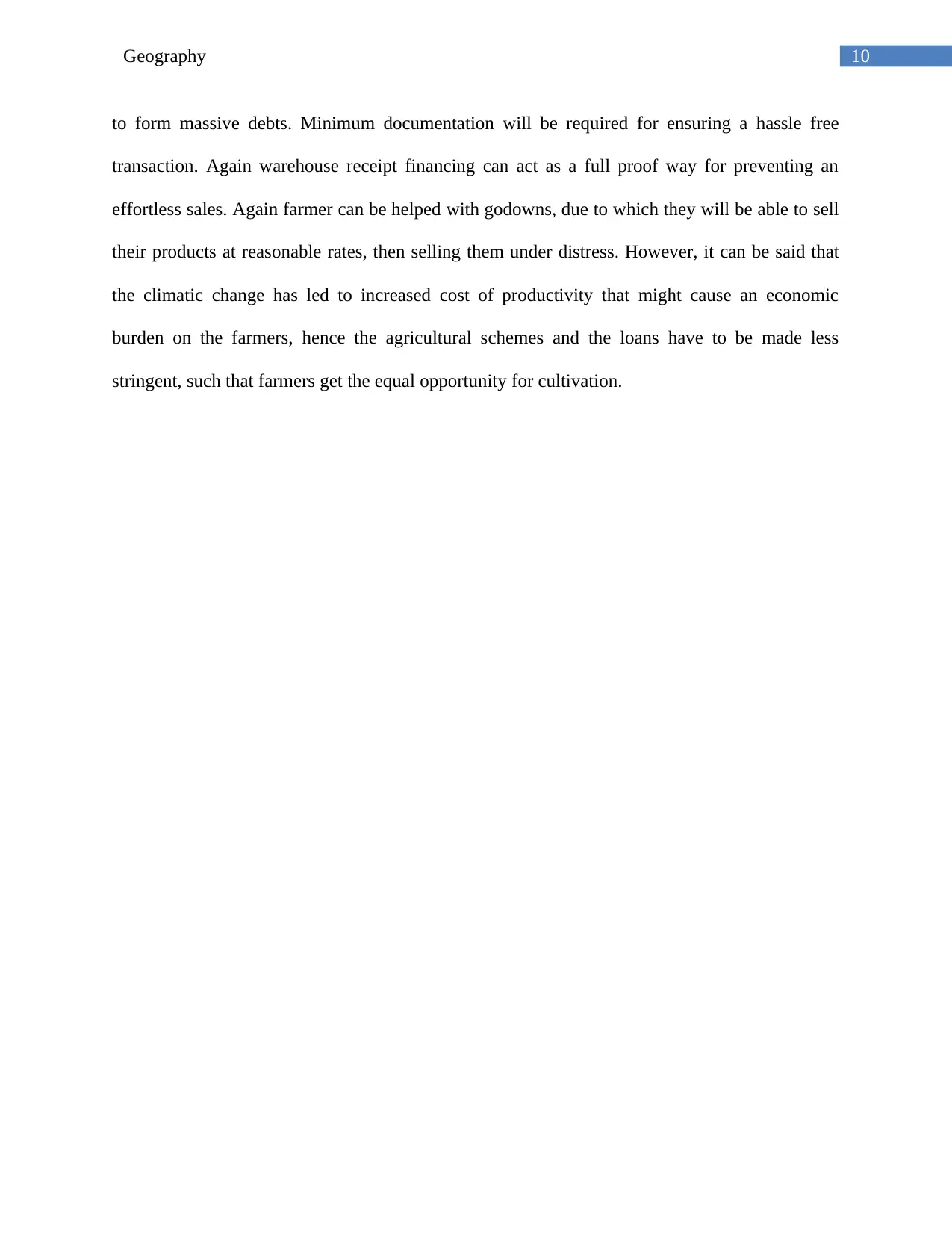
10Geography
to form massive debts. Minimum documentation will be required for ensuring a hassle free
transaction. Again warehouse receipt financing can act as a full proof way for preventing an
effortless sales. Again farmer can be helped with godowns, due to which they will be able to sell
their products at reasonable rates, then selling them under distress. However, it can be said that
the climatic change has led to increased cost of productivity that might cause an economic
burden on the farmers, hence the agricultural schemes and the loans have to be made less
stringent, such that farmers get the equal opportunity for cultivation.
to form massive debts. Minimum documentation will be required for ensuring a hassle free
transaction. Again warehouse receipt financing can act as a full proof way for preventing an
effortless sales. Again farmer can be helped with godowns, due to which they will be able to sell
their products at reasonable rates, then selling them under distress. However, it can be said that
the climatic change has led to increased cost of productivity that might cause an economic
burden on the farmers, hence the agricultural schemes and the loans have to be made less
stringent, such that farmers get the equal opportunity for cultivation.
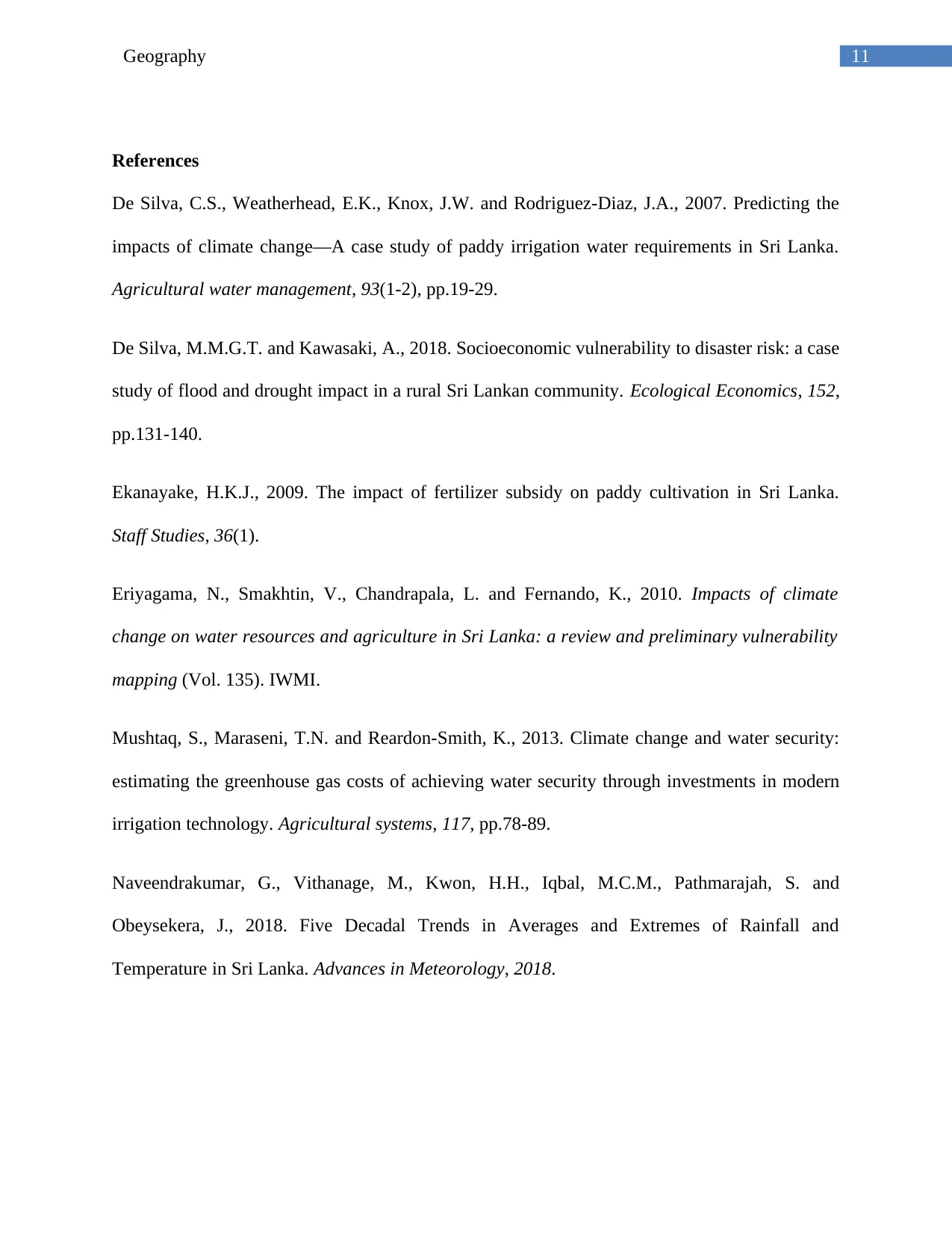
11Geography
References
De Silva, C.S., Weatherhead, E.K., Knox, J.W. and Rodriguez-Diaz, J.A., 2007. Predicting the
impacts of climate change—A case study of paddy irrigation water requirements in Sri Lanka.
Agricultural water management, 93(1-2), pp.19-29.
De Silva, M.M.G.T. and Kawasaki, A., 2018. Socioeconomic vulnerability to disaster risk: a case
study of flood and drought impact in a rural Sri Lankan community. Ecological Economics, 152,
pp.131-140.
Ekanayake, H.K.J., 2009. The impact of fertilizer subsidy on paddy cultivation in Sri Lanka.
Staff Studies, 36(1).
Eriyagama, N., Smakhtin, V., Chandrapala, L. and Fernando, K., 2010. Impacts of climate
change on water resources and agriculture in Sri Lanka: a review and preliminary vulnerability
mapping (Vol. 135). IWMI.
Mushtaq, S., Maraseni, T.N. and Reardon-Smith, K., 2013. Climate change and water security:
estimating the greenhouse gas costs of achieving water security through investments in modern
irrigation technology. Agricultural systems, 117, pp.78-89.
Naveendrakumar, G., Vithanage, M., Kwon, H.H., Iqbal, M.C.M., Pathmarajah, S. and
Obeysekera, J., 2018. Five Decadal Trends in Averages and Extremes of Rainfall and
Temperature in Sri Lanka. Advances in Meteorology, 2018.
References
De Silva, C.S., Weatherhead, E.K., Knox, J.W. and Rodriguez-Diaz, J.A., 2007. Predicting the
impacts of climate change—A case study of paddy irrigation water requirements in Sri Lanka.
Agricultural water management, 93(1-2), pp.19-29.
De Silva, M.M.G.T. and Kawasaki, A., 2018. Socioeconomic vulnerability to disaster risk: a case
study of flood and drought impact in a rural Sri Lankan community. Ecological Economics, 152,
pp.131-140.
Ekanayake, H.K.J., 2009. The impact of fertilizer subsidy on paddy cultivation in Sri Lanka.
Staff Studies, 36(1).
Eriyagama, N., Smakhtin, V., Chandrapala, L. and Fernando, K., 2010. Impacts of climate
change on water resources and agriculture in Sri Lanka: a review and preliminary vulnerability
mapping (Vol. 135). IWMI.
Mushtaq, S., Maraseni, T.N. and Reardon-Smith, K., 2013. Climate change and water security:
estimating the greenhouse gas costs of achieving water security through investments in modern
irrigation technology. Agricultural systems, 117, pp.78-89.
Naveendrakumar, G., Vithanage, M., Kwon, H.H., Iqbal, M.C.M., Pathmarajah, S. and
Obeysekera, J., 2018. Five Decadal Trends in Averages and Extremes of Rainfall and
Temperature in Sri Lanka. Advances in Meteorology, 2018.
⊘ This is a preview!⊘
Do you want full access?
Subscribe today to unlock all pages.

Trusted by 1+ million students worldwide
1 out of 13
Your All-in-One AI-Powered Toolkit for Academic Success.
+13062052269
info@desklib.com
Available 24*7 on WhatsApp / Email
![[object Object]](/_next/static/media/star-bottom.7253800d.svg)
Unlock your academic potential
Copyright © 2020–2025 A2Z Services. All Rights Reserved. Developed and managed by ZUCOL.